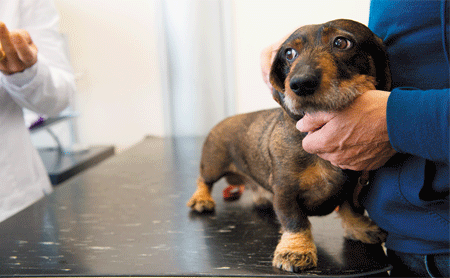What 'taking them to the back' means for your patients
This veterinary behavior specialist says youre reading your patients all wrong. Bonus: The simplest, most important low-stress practice tip everyone in the veterinary world can use.

"Should I stay or should I go?" (Photo: Shutterstock.com/Ivonne Wierink) Editors' note: This was taken from a recent episode of Your Veterinary Voice, a podcast where we sit down with the experts of the veterinary world and gain further insight into what they're doing, why they're doing it and what they have to say.
Are pets really better in the back, away from their owners?
Many veterinarians take animals from their owners. Not for any nefarious reasons, and not for long-they just have to efficiently run a hospital. “I can't run a hospital if every exam room is filled with a technician taking blood. It's an efficiency issue," says Lisa Radosta, DVM, DACVB, a veterinary behavior specialist and owner of Florida Veterinary Behavior Service in West Palm Beach, Florida. “I can't train my staff with the owner standing over them-they feel like they can't make mistakes, and that's a lot of pressure.”
So to help the function of the veterinary clinic run smoothly, veterinarians and technicians take animals from their owners to the back. And it's not a big deal-many, if not most, will find that the animal does well without the owner looming, sometimes even better than if the owner were present. So what's the problem?
The problem, according to Dr. Radosta, is that it's a lie. “I think that is complete untruth. If we act like scientists and take a step back and look at the problem, we can see that they are in the ‘freeze' portion of ‘fight, flight, freeze'. They're petrified." In other words, just because they aren't growling or reacting as they were with the owner present doesn't mean that they're calmer without the owner there; it means that they're just too afraid to react.
Dr. Radosta compared it to someone's first day at a brand new job, where they wouldn't know anyone and wouldn't be familiar with their surroundings. “You won't be cursing or fist bumping the other guys in the office. If you're with people you don't know, you can't act like that because you're too nervous.”
So what's the solution?
According to Dr. Radosta, it's simple: educate. “Recognize what you're actually seeing, stop perpetuating a lie, and help the client to help the pet.”
Offer your clients a job
According to Dr. Radosta, if the animal is being restrained and the client is freaking out, that spells trouble for everyone involved. To solve this, Dr. Radosta says that she doles out tasks for the clients to uphold. “We give the clients a job before we touch the animal. If they don't do the job, we will intervene and say, ‘Ms. Jones, you need to put the peanut butter up to your dog's mouth', or something along those lines.” Giving your clients a task to do during the visit keeps your clients busy, and everyone else just a little bit calmer.
Dr. Radosta recognizes that it's a common joke to say that veterinarians are doctors who just don't enjoy talking to people. She also knows that there are veterinary staff members out there that think the duty of paying attention to your clients on top of everything else you must do is just too much. She disagrees with both. “Paying attention to the clients, the staff and the patients is your job. You should know how to talk to your clients and make them feel comfortable.”
There's also a number one low-stress practice tip that goes hand in hand with all of this, according to Radosta: Recognition of fear and stress in patients. She says that with all of what is taught in veterinary school, it's rare to be taught to identify fear. “As a veterinarian, you have to know so much,” says Radosta. “I would like to teach in veterinary school to recognize fear. If we can teach that, we've done our jobs, because once they see that there is fear in something they're doing, they won't do it anymore.”
To hear more of the great advice that Dr. Radosta has to give, you can listen to the rest of her podcast here. Want even more advice from top names of the veterinary world? Here are the rest of the episodes of Your Veterinary Voice.